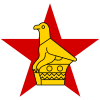2000s in Zimbabwe
|
| Other decades |
| 1980s | 1990s | 2000s | 2010s | 2020s |
| History of Zimbabwe | ||||||||||||||||||||||||||||||||||||||||||
|---|---|---|---|---|---|---|---|---|---|---|---|---|---|---|---|---|---|---|---|---|---|---|---|---|---|---|---|---|---|---|---|---|---|---|---|---|---|---|---|---|---|---|
 | ||||||||||||||||||||||||||||||||||||||||||
Ancient history
|
||||||||||||||||||||||||||||||||||||||||||
White settlement pre-1923
|
||||||||||||||||||||||||||||||||||||||||||
Zimbabwe began experiencing a period of considerable political and economic upheaval in 1999. Opposition to President Mugabe and the ZANU-PF government grew considerably after the mid-1990s in part due to worsening economic and human rights conditions.[1] The Movement for Democratic Change (MDC) was established in September 1999 as an opposition party founded by trade unionist Morgan Tsvangirai.
The MDC's first opportunity to test opposition to the Mugabe government came in February 2000, when a referendum was held on a draft constitution proposed by the government. Among its elements, the new constitution would have permitted President Mugabe to seek two additional terms in office, granted government officials immunity from prosecution, and authorised government seizure of white-owned land. The referendum was handily defeated. Shortly thereafter, the government, through a loosely organised group of war veterans, sanctioned an aggressive land redistribution program often characterised by forced expulsion of white farmers and violence against both farmers and farm employees.
Parliamentary elections held in June 2000 were marred by localised violence, and claims of electoral irregularities and government intimidation of opposition supporters. Nonetheless, the MDC succeeded in capturing 57 of 120 seats in the National Assembly.
- ^ "REPORT: Policing the State – an evaluation of 1,981 political arrests in Zimbabwe: 2000–2005". ZimOnline. 15 December 2006. Archived from the original on 28 September 2007.